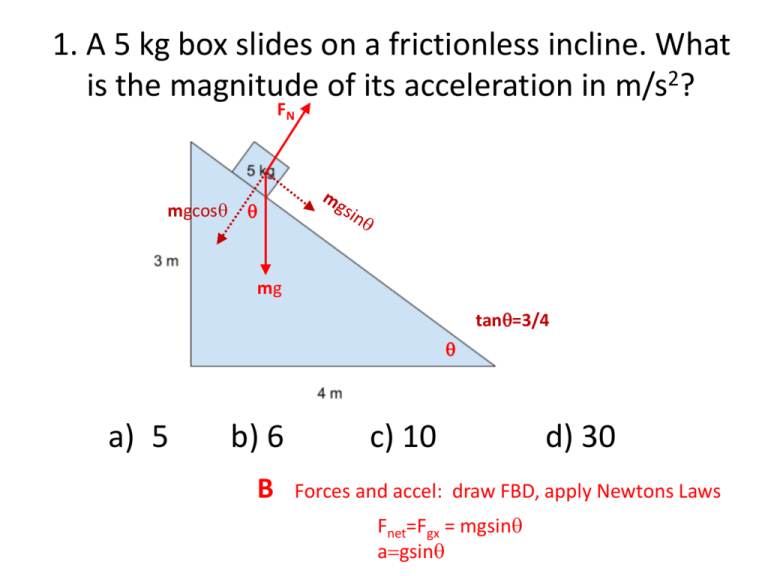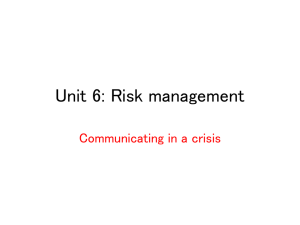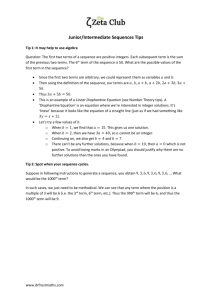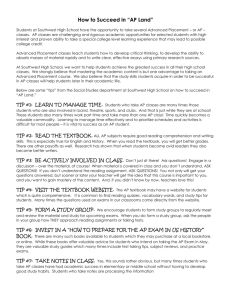ppt Review from Kahoot
advertisement

1. A 5 kg box slides on a frictionless incline. What is the magnitude of its acceleration in m/s2? FN mgcosq q mg tanq=3/4 q a) 5 b) 6 B c) 10 d) 30 Forces and accel: draw FBD, apply Newtons Laws Fnet=Fgx = mgsinq a=gsinq 2. Same box, same frictionless incline. What is the magnitude of the normal force on the box? a) 30 N b) 40 N B c) 50 N Tips: FN =Fgy = mgcosq d) 60 N 3. If the box started from rest at the top, what is its kinetic energy at the bottom? a) 150 J A b) 250 J c) 50 J d) 60 J Tips: asks about energy so apply conservation of energy to the problem UgT= mgh= KB 4. The net work done on an object is always equal to its change in: a) Gravitational Potential Energy b) Elastic Potential Energy c) Kinetic Energy d) Mechanical Energy C 5. A 30 kg mass hangs still from a spring with a k = 1500 N/m. How much is the spring stretched? C a) 0.002 m c) 0.2 m b) 0.02 m d) 2 m Fspr Tip: draw FBD, block is at rest, all forces are balanced Since block is at rest Fspr = mg kx = mg x = mg/k mg 6. The surface is frictionless. What is the tension in the rope connecting the two boxes? F a) (2/5)F D b) (5/2)F c) (2/7)F d) (5/7)F Tips: T is the net force on 5kg box which is 5/(2+5) F System: asys = F/7 5kg box: Fnet=T=5a=5(F/7) 7. The surface is frictionless. What is the tension in the rope connecting the two boxes? a) (2/5)F C b) (5/2)F c) (2/7)F d) (5/7)F Tips: T is the net force on 2kg box which is 2/(2+5) F System: asys = F/7 2kg box: Fnet=T=2a=2(F/7) 8. The surface is frictionless. The acceleration of the two masses is: System mg a) g b) g/2 C c) g/3 d) 2g/3 Tips: asys = Fnet sys/Msys = mg/3m 9. The surface is frictionless. The tension in the rope is: FN FT 2mg a) 2mg/3 A b) mg/2 c) mg/3 d) mg Tips: FT is net force on 2m Fnet 2 = FT = 2ma = 2mg/3 (2/3rds of Fnetsys) 10. The surface has friction. The masses don't move. What's the minimum μs of the surface/box? FN FT fs FT 2mg mg a) 0.333 B b) 0.5 c) 0.67 d) 2 Tips: Draw FBD, Net force on each block is 0 Fnet 2 = FT-fs = 0 and FT=mg mg=ms(2mg) 11. A car slams its brakes and stops in a distance d. Another car moving twice as fast... a) d/2 D b) d c) 2d d) 4d Tips: want relationship between v0 and d, all else constant : v2=v02+2ad (v = 0 and ax is same ) d=v02/2a (double v0 results in 4x d OR W-E: Wnet=DK -Fbraked = 0-1/2 mv02 d= mv02/(2Fd) 12. A car is parked on a level surface. The surface exerts an upward normal force on the car. a) b) c) d) The downward force of gravity on the car The downward force of the car on the surface The upward force the car exerts on the earth The force of friction between the tires and the surface B Tip: can write F fully accounting for the pair of objects involved in the interaction: FN, on car, by surface Then the equal and opp force is FN, on suface, by car N 13. The period of a satellite's orbit depends on... C a) b) c) d) I and II only I, II, and III I and III only II and III only Tips: the trajectory of a satellite DOES NOT depend on the mass of the satellite. Because a satellite is in free fall its acceleration is mass-independent. Orbital Motion: FG = FC and v=2pR/T GMm/R2=mv2/R GM/R= (2pR/T)2 T depends on M, mass of central planet and R, the orbital radius 14. A planet has twice the radius of earth, and the same density as earth. a) 10 m/s2 c) 20 m/s2 b) 5 m/s2 d) 2.5 m/s2 C Tips: express g in terms of density g = GM/R2 = (4/3)pRr where r = M/V . Same density, 2x s R gives 2x g of Earth 15. A car moves clockwise around a circular track (as viewed from above). a) North c) South b) East d) West A ac v 16. A truck of mass m and a speed v passes the top of a circular hill with a radius R. FN mg B Tip: FORCE so draw FBD Car is moving in a curved (circular) path, so there must be a centripetal force. Apply Newtons 2nd FC = Fr = mv 2 / R mg FN = mv 2 / R a) mv2/R c) (mv2/R)-mg b) mg-(mv2/R) d) mg+(mv2/R) 17. A mass m is supported by two ropes, as shown. The rope on the left is horizontal. T2sinq T1 T2 T2cosq mg C Tip: FORCES so draw FBD m is in equilibrium: All forces are balanced (Fnet = 0) F y =0 T2 sin q mg = 0 a) mgcosq c) mg/sinq b) mgsinq d) mg/cosq 18. A ball of mass m is tied to a string of length L and released with string 60o from vertical.. Lcos60 L h=L-Lcos60 =0.5L ET=EB mgh=1/2mvB2 vB=(2g(0.5L)) = (gL) a) (gL) A b) (2gL) c) (gL/2) d) (4gL) Tip: In the absence of air resistance, a pendulum/Earth system conserves mech E (T does no work, it is a centripetal force) 19. A box of mass m on a frictionless surface is attached to a spring with a spring constant k. Max velocity when all the US is converted to K (when the spring is at relaxed, equilib position: a) (dk/m) b) d(k/m) B c) d(m/k) Ei=Ef 1/2kd2=1/2mvf2 vf = d(k/m) d) (k/dm) Also only B has units of velocity Tip: Cant use kinematics with springs because the spring force (and acceleration) is not constant. In the absence of friction, the block/spring system conserves mech E 20. A car with a speed v brakes and skids to a stop. The coefficient of kinetic friction is μ. a) 2v2/(mg) D b) v2/(mg) c) 2mg/v2 d) v2/(2mg) Tips: can eliminate C based on wrong units. consider EITHER Forces (draw FBD and apply Newtons 2nd, use kinematics) OR Work-Energy (Ei + WNC = Ef) (car/Earth is not isolated, Wf removes mech E) FN v fk F = ma x x f k = ma x mmg = ma mg OR a = mg v f = v0 2a x d 2 2 d = v0 /(2a ) = v 2 /(2 mg ) 2 Ei W f = E f 1 2 mv 2 f k d = 0 1 2 mv 2 mmgd = 0 d = v 2 /(2 mg ) 21. A truck of mass m and a speed v passes the top of a circular hill with a radius R. C mg Tip: only C and D have the correct units Car is moving in a curved (circular) path, so there must be a centripetal force. Draw FBD. Apply Newtons 2nd. Truck looses contact when FN = 0 FC = Fr = mv 2 / R mg = mv 2 / R v = gR a) gR2 b) gR c) (gR) d) (2gR) 22. The graph below shows the net force that acted on a mass over a displacement of 8.0 meters. Fav = 5N a) 40 J b) 24 J Fav = 6N c) 44 J C d) 66 J Tip: Work is area under F-d curve or Favd for each linear region 23. The graph below shows the net force that acted on a mass over a displacement of 8.0 meters. B Tip: Wnet=DK Wnet=DK 44 = Kf-Ki 22=1/2mvf2 vf=2m/s a) 1 m/s b) 2 m/s c) 3 m/s d) 4 m/s 24. Why can a car travel with a greater speed w/o slipping on a banked curve than on level ground? a) b) c) d) The force of friction is greater on the banked track. Gravity helps supply centripetal force. Normal force increases on the banked track. The normal force helps supply centripetal force. D 25. Which graph shows the relationship between gravitational potential energy and height? A Ug=mgh 26. A ball thrown straight up with a speed v reaches a maximum height h. a) 2h D b) 4h c) 8h d) 16h Tips: want relationship between h and v0 , all else constant : Kinematics: vfy2=v0y2+2ayh (vfy = 0 at peak and ay is same ) h=v02/2g (4x v0 results in 16x h) OR Conservation of Mech E EB=ET 1/2mv02=mgh h=v02/2g 27. A ball is thrown straight up with an initial kinetic energy K and reaches a maximum height h. a) 2h B b) 4h c) 8h d) 16h Tips: Conservation of Mech E EB=ET KB=UGT Find relationship between K and h KB=mgh h=KB/mg (if 4x K, h increases 4xs) 28. What's the max speed (w/o slipping) a car can have on a flat circular track with μs & radius R? B Tip: Car is moving in a circular path, so there must be a centripetal force. Draw FBD. Apply Newtons 2nd. FN Note – Only b has the correct units fS FC = Fr = mv 2 / R mg fs max = mvmax / R 2 m s mg = mvmax 2 / R vmax = m s gR a) msgR b) (msgR) c) (ms/gR) d) ms/gR 29. A 2 kg ball is thrown downward with an initial speed of 20 m/s from the top of a 50 m cliff. a) 900 J b) 1400 J c) 400 J ET W f = E B D W f = E B ET W f = ( K B U gB ) ( K T U gT ) = 12 mvB ( 12 mvT mghT ) 2 d) 500 J 2 = 30 2 (20 2 1000) = 900 1400 = 500 J 30. A 5 kg bowling ball is tied to a string and hung from the ceiling of an elevator, as shown. D FT a=-3m/s2 mg Tip: Forces and accel – draw FBD, apply Newtons 2nd F y = ma y FT mg = ma y FT = mg ma y = 5(10 3) = 35 N a) 50 N b) 65 N c) -15 N d) 35 N 31. A ball is dropped. Which graph shows its kinetic energy vs. time as it falls? C Tips: K is directly related to v2 How is v2 related to t? v=gt and v2=g2t2 Therefore K is related to t2. It is a parabolic relationship 32. A 5 kg bowling ball is tied to a string and hung from the ceiling of an elevator, as shown. A FT mg Tips: Forces and accel – draw FBD, apply Newtons 2nd . CONSTANT SPEED means NO ACCEL. Circle it everytime you see it. All forces on ball are balanced a) 50 N b) 25 N c) 75 N d) 0 N 33. A box of mass m is attached to a spring with a spring constant k. Set Ug = 0 at level of box. Initial – spring is stretched, all energy is US Final – spring at equilib and block at rest. D a) kd2/(mg) c) kd/(mg) b) kd2/(2mg) d) kd/(2mg) Ei + Wf = Ef 1/2kd2 + fkd = 0 1/2kd2 + mkmgd = 0 mk = kd/(2mg) Tip: Cant use kinematics with springs because the spring force (and acceleration) is not constant. Use conservation of energy (Ei+WNC=EF). Work done by friction removes mech E 34. A box hangs stationary on the end of a vertical spring with a spring constant k. Fspr = mg kx = mg m = kx/g Fspr A mg a) kx/g Tip: draw FBD, block is at rest, all forces are balanced Since block is at rest Can eliminate c because the units are not kg b) kx/(2g) c) kx2/(2g) d) 2kx/g 35. Which graph shows the correct potential energy U of a standard spring vs. its stretch, x? C US=1/2kx2








